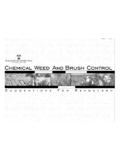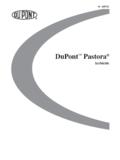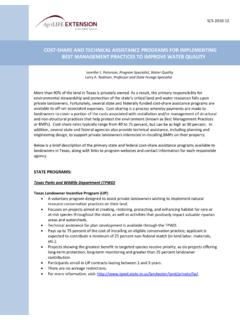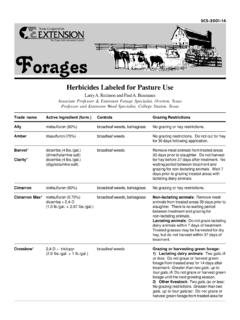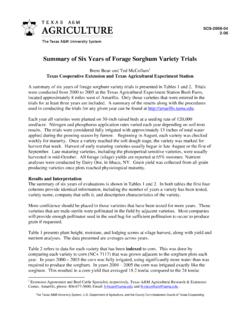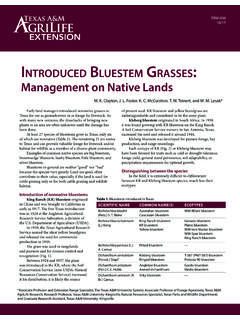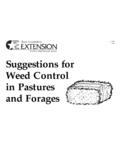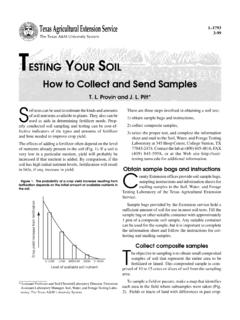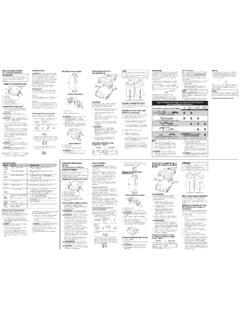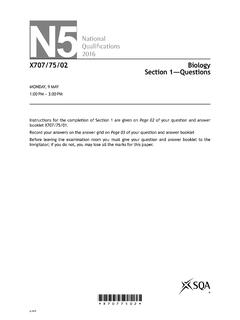Transcription of BERMUDAGRASS VARIETIES, HYBRIDS AND BLENDS FOR …
1 SCS 2009 11 BERMUDAGRASS varieties , HYBRIDS AND BLENDS FOR TEXAS. Vanessa A. Corriher and Larry A. Redmon Extension Forage Specialists Overton and College Station, TX. BERMUDAGRASS (Cynodon dactylon) is native to southeast Africa. The earliest mention of BERMUDAGRASS comes from the diary of Thomas Spalding, owner of Sapeloe Island, Georgia and a prominent antebellum agriculturalist. Found in his diary was the following entry: BERMUDAGRASS was brought to Savannah in 1751 by Governor Henry Ellis. He went on to say that If ever this becomes a grazing country it must be through the instrumentality of this grass. Writers as early as 1807 referred to BERMUDAGRASS as one of the most important grasses in the South at the time. Thus, BERMUDAGRASS has been a part of southern agriculture for at least 250 years.
2 hybrid BERMUDAGRASS with improved productive capability and nutritive value has played an important role in livestock production across the southern US. for nearly 60 years with the introduction of Coastal' in 1943. BERMUDAGRASS is a warm-season perennial grass that spreads by rhizomes (underground stems) and/or stolons (horizontal aboveground stems). The grass tolerates a wide range of soil types and soil pH values, thus it is adapted to most of the southern US. Limited cold tolerance in early common and hybrid cultivars of BERMUDAGRASS led to the release of several cold-tolerant varieties . These cold tolerant varieties are useful for the warm- and cool-season transition areas of the US, including Oklahoma, Arkansas, Missouri, and Tennessee.
3 Although capable of high production, BERMUDAGRASS must be well-fertilized to reach maximum production capability (Table 1 and 2). Given adequate moisture, nitrogen (N) is usually the most limiting factor to forage production, but appropriate levels of phosphorus (P) and potassium (K). are critical to yield and persistence. Adequate pH ( ) is also important in maintaining a vigorous stand of BERMUDAGRASS . Table 1. Coastal BERMUDAGRASS dry matter (DM) yield as affected by fertilizer and broiler litter application Application rate DM 1992 DM 1993. (lbs/ac) (lbs/ac) (lbs/ac). N-P205-K20. (lbs/ac). 0-0-0 4780 4050. 100-33-67 7140 6450. 200-67-134 8680 8290. 400-134-268 9640 10460. Poultry litter (tons/ac). 2 SPR + 2 SUM2 7580 6930.
4 4 SPR 8320 7450. 4 SPR + 4 SUM 8850 7840. 8 SPR 9810 9270. 1. Evers, 1998. 2. SPR is late spring and SUM is mid-summer. Table 2. Warm-season perennial grass yields from 1997 through 2001. 1997 1998 1999 2000 2001 Average Entry ---------------------------------------l b dry matter/ac----------------------------- Tifton 85 bermuda1 5044 a2 8064 a 12915 a 12032 a 15680 a 10747 a CD 90160 bermuda 2737 b 3550 d 9696 bc 10347 b 13395 a-c 7945 b Texas Tough bermuda 2480 bc 5262 b 11749 ab 7956 e-g 10993 cd 7688 b Ranchero Frio bermuda 1943 cd 2912 de 8984 c 9991 bc 12428 b-d 7251 bc Terra Verde bermuda 2085 cd 4885 bc 9054 c 8318 d-f 11748 b-d 7218 bc Coastal bermuda1 1611 d 3739 cd 8507 cd 9440 b-d 11549 b-d 6969 bc Cheyenne bermuda 2408 bc 3430 de 6640 d-f 8928 c-e 13431 ab 6967 bc KF CD 194 bermuda 1914 cd 3664 cd 7407 c-e 7525 fg 10075 de 6117 c Pensacola bahia 583 e 2167 e 4771 f 6809 gh 7682 ef 4402 d
5 Tifton 9 bahia 767 e 2203 e 5470 ef 5967 h 7398 f 4361 d Common bermuda3 383 7445 fg 11352 b-d 6393. Giant bermuda3 836 7356 fg 6643 f 4945. Wrangler bermuda3 188 6744 gh 7550 f 4827. Kikuyugrass3 0 7620 e-g 5539 f 4386. 1. BERMUDAGRASS varieties established from sprigs. 2. Entries planted in 1999. All other entries planted in 1997. Inadequate levels of N not only limit BERMUDAGRASS dry matter production, but also reduce crude protein levels. Less than optimum BERMUDAGRASS growth can also allows weed infestation, which reduces carrying capacity and increases input costs. BERMUDAGRASS is highly responsive to N fertilization, but regardless of N input low levels of K can lead to reduced yields, poor stands and winter-kill. Phosphorus is important for many plant growth functions, including root growth and development.
6 Careful attention to soil fertility, beginning with an annual soil test to determine the soil nutrient status is necessary to ensure maximum BERMUDAGRASS growth, disease resistance, and cold tolerance. Besides providing good nutrition for cows during the growing season, BERMUDAGRASS is used extensively in hay production for winter feeding. Although this practice is generally an expensive way to winter cattle, it is a popular practice across most of the South. Other uses of BERMUDAGRASS for winter feeding may help reduce costs. These uses include standing or stockpiled BERMUDAGRASS for fall and early winter grazing or overseeding BERMUDAGRASS swards with cool-season annual forages such as small grains, ryegrass, clovers or medics to provide late winter and spring grazing.
7 The combined use of stockpiled BERMUDAGRASS and overseeded ryegrass can reduce winter feeding costs by up to $100 per cow through the winter. Warm-season perennial grasses such as BERMUDAGRASS generally have lower nutritive value compared to warm-season annuals or cool-season forages. However, good fertility practice (Table 3) and careful attention to stage of maturity at harvest (Table 4) can provide forage of good to excellent nutritive value. Table 3. Coastal BERMUDAGRASS crude protein (CP) content as affected by fertilizer and broiler litter application ---------------------------------------- ---------CP----------------------------- --------------------- (% DM). --------------------1992---------------- -- --------------------1993---------------- -- Application rate June July Aug Sept Oct May June July Aug Sept (lbs/ac) 11 9 6 8 7 7 17 19 23 22.
8 N-P205-K20. (lbs/ac). 0-0-0 100-33-67 200-67-134 400-134-268 Poultry litter (tons/ac). 2 SPR + 2 SUM2 4 SPR 4 SPR + 4 SUM 8 SPR 1. Evers, 1998. 2. SPR is late spring and SUM is mid-summer. Table 4. Effect of clipping frequency on yield and nutritive value of Coastal' BERMUDAGRASS Clipping DM Leaf Crude Lignin Interval Yield (%) Protein (%). (wk) (tons/ac) (%). 1 --- . 2 3 4 6 8 1. Burton and Hanna, 1995. BERMUDAGRASS has many uses other than pasture and hay, such as lawns, general-purpose turf, and erosion control. The following are descriptions of the various cultivars and collections of BERMUDAGRASS grown in East Texas: SEEDED BERMUDAGRASSES. Seeded varieties can be used on small acreages that are not economical to sprig and on steep slopes and cut-over timberland where good seedbed preparation necessary for sprigging is not feasible.
9 Most seeded BERMUDAGRASS on the market are BLENDS that contain 2 to 4 lines and frequently contain Giant (NK. 37) and common. Components of some of the BLENDS on the market are reported in Table 5. A comparison of DM yield of several seeded varieties at Overton, TX are reported in Table 6. The percentage of each line in the blend may vary from year to year depending on seed availability and cost. CHEYENNE. Cheyenne is a cross between a BERMUDAGRASS from an old turf site in the Pacific Northwest and another plant from former Yugoslavia. Jacklin Seed Company and Pennington Seed developed and released this cultivar in 1989. It was originally released as a turfgrass but was promoted as a pasture variety by the mid-90's. Like common BERMUDAGRASS , Cheyenne establishes quickly.
10 Cheyenne produced the least dry matter yield of the seeded bermudagrasses in a 5-year evaluation trial at Overton (Table 2). COMMON. A highly variable variety in appearance and that responds favorably to good management in East Texas. Common may be found growing under almost every conceivable condition throughout the BERMUDAGRASS -growing region. It can be considered a forage grass, a turf grass or a noxious weed. Because of the long experience with common, it is often used as a standard for evaluating new material. Common dry matter yields are generally about 1/3 lower than Coastal with the forage nutritive value and forage quality being about the same. It is generally more winter hardy than the HYBRIDS . GUYMON. Guymon is a synthetic cultivar developed from parental lines found in Yugoslavia and growing near Guymon, Oklahoma.
